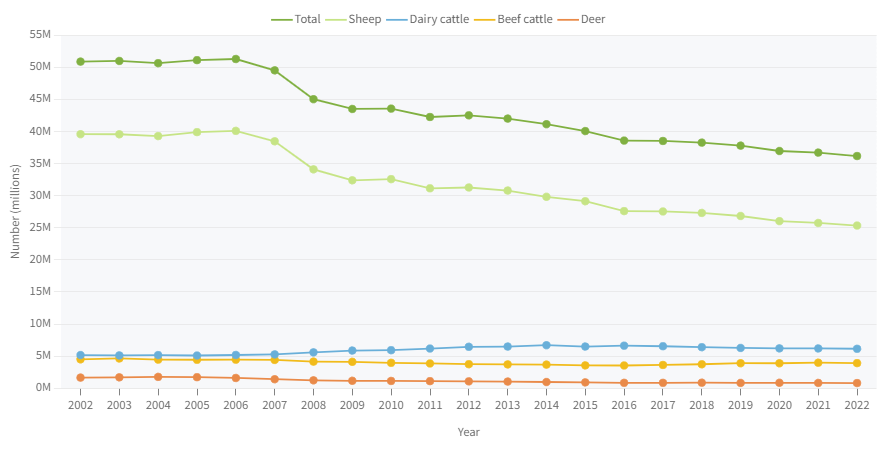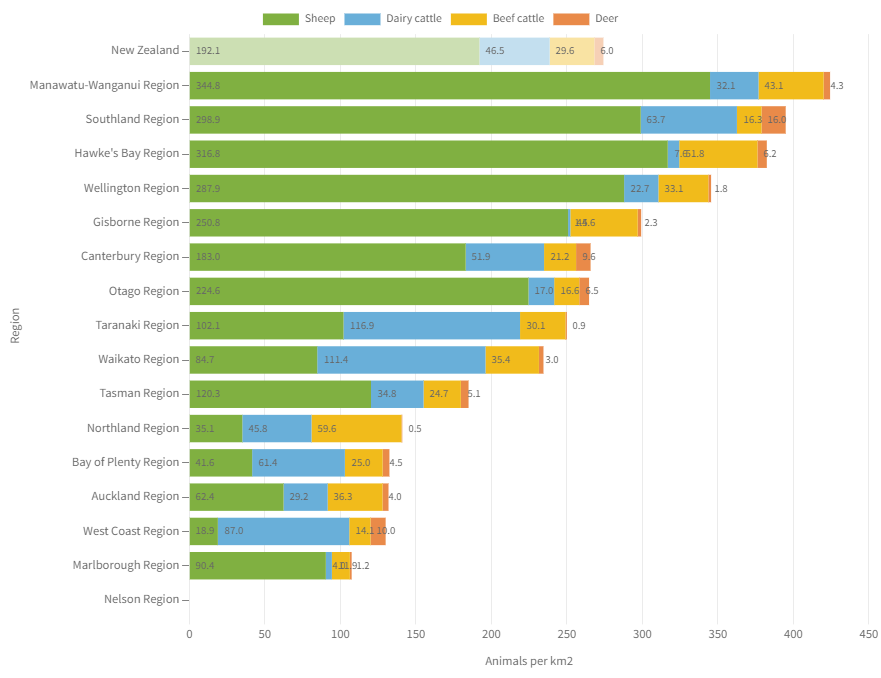Agricultural activity
This section provides information about agricultural activity and its relationship to recreational water quality in Aotearoa New Zealand, using data sourced from Statistics New Zealand.
The agricultural sector plays an important role in New Zealand’s economy. However, poorly managed livestock and agricultural production can have a major impact on the environment.
Recreational water bodies can be contaminated with effluent from farm animals or chemical runoff of fertiliser product. Faecal bacteria from this waste can cause gastrointestinal or respiratory diseases, while chemicals such as nitrogen and phosphorus commonly used in fertilisers can contribute to the growth of toxic algae.
Note: As of December 2025, EHINZ is awaiting corrections to the latest agricultural production data from Statistics New Zealand before we can update these indicators.
On this page:
Agricultural activity has a major effect on recreational water
Agricultural use of land can cause bodies of water that are used by people for recreational activities (such as swimming, boating, and fishing) to become contaminated in several ways (Ministry for the Environment & Statistics New Zealand 2023):
- Storm run-off of livestock waste from farms into water sources can affect water quality by introducing pathogens such as Campylobacter, Cryptosporidium, E.coli, and Giardia contained in sheep and cow dung. These pathogens can cause gastrointestinal or respiratory diseases, especially in immunocompromised people (Devane et al. 2018).
- Biological contaminants such as pesticides and pharmaceuticals used to treat livestock have been detected in waterways internationally and are shown to potentially increase development and spread of antimicrobial resistance (Alderton et al. 2021).
- Excess nutrients, such as nitrogen from fertiliser or livestock urine, can be washed into waterways by rain and reduce water quality by promoting the growth of potentially toxic algae.
- Irrigation for intensive farming of livestock is one of the largest uses of freshwater in New Zealand. which may lower the water levels in rivers. Lowered water levels can interrupt river flow and prevent harmful contaminants from being ‘flushed’ out of a waterway.
Additionally, agriculture is a notable contributor to greenhouse gas emissions. The methane (CH4) produced by dairy cattle and sheep constitutes roughly a third of New Zealand’s greenhouse gas emissions, making it one of the largest sources of emissions in the country (Landcare Research 2020).
Overall, livestock numbers are in decline
There were 36.2 million stock animals in New Zealand in 2022. Between 2002 and 2022, the number of stock animals in New Zealand decreased by about a third, from 50.9 million to 36.2 million (Figure 1).
The bulk of the decline relates to decreasing sheep numbers, which reduced by just over a third (36.0%) during this period. Despite the reduction in numbers, sheep still outnumbered all other livestock types combined by a factor of just over two to one as of 2022.
Figure 1: Number of livestock, by type, 2002-2020

Source: Statistics New Zealand 2023. The data for 2002, 2007, 2012, 2017, and 2022 were collected from census data, whereas the other years were collected from surveys.
The Manawatū-Whanganui region had the greatest density of livestock in 2022
In 2022, the regions with the highest densities of livestock were Manawatū-Whanganui region had the highest density of livestock (424.4 animals per km2) (Figure 2), closely followed by Southland (394.9) and Hawke’s Bay (382.5) (Figure 2).
As well as having the greatest density of livestock overall, the Manawatū-Whanganui region also had the highest density of sheep: 344.8 animals per km2 of farmland.
As for other types of livestock (Figure 3):
- the greatest concentration of dairy cattle was in Taranaki (116.9 per km2),
- beef cattle were most densely farmed in the Northland region (59.6 per km2)
- deer were densest in the Southland region (16.0 per km2)
Figure 2: Livestock density, by regional council and livestock type, 2022

Note: Density is calculated based on the total area of farmland in a region, as listed in the 2022 Agricultural Census, not the area of farmland used explicitly for stock grazing. Data for the Nelson region was suppressed at the data source due to low response rate or high data errors.
The area of agricultural land is decreasing
Between 2007–2017, the area of land in New Zealand used for agricultural purposes decreased by 5.4%, an area equivalent to 800,490 hectares. The bulk of the decline was in the Canterbury and Otago regions, which account for 70.6% of the decline between them (with a reduction of 339,925 and 255,237 hectares respectively).
Agricultural land makes up at least 50% of the area of almost all regions (Figure 4). Consequently, New Zealand uses a little over half of its entire land area for agricultural purposes. Though most regions experienced a reduction in agricultural land between 2007–2017, farmland expanded in a few regions. Notable expansions occurred in Auckland and Bay of Plenty, where an additional 8.6% and 6.5% (respectively) of the region’s land area was converted to farmland. The largest decline was in the Otago region, where 8.2% of the region’s land was converted from farmland to other uses.
Figure 4: Agricultural land as a percentage of regional area, 2007 & 2017
Between 2007 and 2017, the area of farmland used exclusively for sheep farming decreased by an area equivalent to 29% of all farmland (Figure 5). The number of sheep farmed in New Zealand also declined by around a third during that period, suggesting sheep are not being farmed more intensely given the smaller area. The agricultural sector’s diversification away from specialised sheep farming is indicated by the area of mixed sheep & beef farming quadrupling between 2007 and 2017.
From an environmental perspective, a given number of cattle tends to have a greater impact on their environment than an equivalent number of sheep owing to their greater mass, higher feed requirements and increased output of waste in the form of faecal matter and methane emissions.
Figure 5: Allocation of farmed area, by farm type, 2007–2017 (percentage of total farmed area)
Irrigation is increasing, but almost exclusive to the South Island
Irrigating agricultural land can place pressure on recreational water bodies by increasing the runoff of agricultural chemicals or faecal pollutants from the land into the water. Between 2002 & 2017, the area of irrigated agricultural land almost doubled from 384,152 to 746,739 hectares, an increase of 94%. Around 84% of all irrigated land is in the South Island, primarily in the Canterbury and Otago regions (Figure 7), accounting for 64% and 13% of the total area respectively.
Figure 7: Area of irrigated land, 2002 & 2017
Measured by volume, surface water (i.e. water from rivers & lakes) provides 73% of all consented freshwater takes for agricultural use (Table 1), most of which is used for irrigation. Surface water takes can affect the speed and volume of water flow in rivers from which water is taken, which in turn can affect the water quality within these waterways. River flow helps to disperse pollutants such as toxic algae and bacteria, so reduced flow can lead to build-ups of these contaminants.
Table 1: Consented annual freshwater takes for agricultural purposes, by region, 2017/18 (shown in billions of litres)
Information about the data
Livestock numbers
Source: Statistics New Zealand - New Zealand Annual Agricultural Production Surveys, and five-yearly Agricultural Production Censuses. For more information, visit the Statistics New Zealand Agricultural Production Statistics webpage.
Agricultural land use
Source: Statistics New Zealand (2002, 2007, 2012 & 2017). Agricultural Production Census. Retrieved from https://www.stats.govt.nz/information-releases/ and http://archive.stats.govt.nz/
Irrigation
Source: Statistics New Zealand (2020). Consented freshwater takes. Retrieved from https://www.stats.govt.nz/indicators/consented-freshwater-takes
